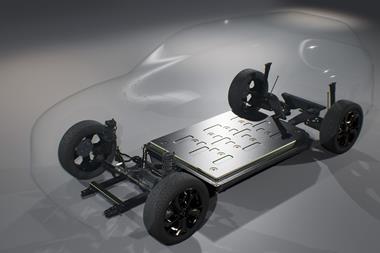Over 90% of manufacturers across all industries rely on metal castings or forgings for production of their engineered goods. Automotive industry castings are worth around $28 billion annually, which is predicted to reach $35 billion by the end of year 2011, while the automotive forging industry accounts for more than $6 billion in annual sales.
Despite being among the most traditional methods of manufacturing, both casting and forging have witnessed remarkable changes in terms of production technology, research and development, investment and cost over recent years. For companies manufacturing castings and forgings, along with the machine shops and coating plants that add part value, the current market represents a period of genuine opportunity, as OEMs look to establish new supply contracts to replace those businesses that have ceased operation due to the economic downturn. Having suitable environmental endorsements is vital for companies seeking such contracts.
Alcoa Wheel Products, a divison of the American aluminium giant Alcoa, claims that by switching to a forged alloy wheel, OEMs can achieve an immediate and significant weight saving, which in turn can lower CO2 output. According to Alcoa, lower wheel weight can offer further benefits including performance and fuel efficiency gains.
Wheels have always been a focal point of exterior design aesthetics. With dimension creep and pedestrian safety legislation raising bonnet lines, wheels have been growing proportionally, with subsequent increases in un-sprung mass impacting ride comfort and CO2 emissions. Cast alloy wheels can be produced cost effectively, but Alcoa Wheel Products believes forging offers an immediate solution, even on an existing vehicle platform, where traditional weight saving programmes can involve costly tooling changes and validation.
Alcoa believes it can extract maximum design benefit from the forging procedure. The company says, as opposed to cast wheels, forging retains a better metal structure (alignment of the aluminium grain structure is retained), offering improved strength and durability. With the appropriate design, this can lead to a significantly lighter wheel.
“Our analysis shows an optimised forged, as opposed to cast or two-piece alloy wheel, can actually save up to 39kg per car,” explains David Yates, Commercial and Marketing Manager for Alcoa Europe. “This is based on a 19” US SUV wheel, but a recent programme in Europe for a sports car manufacturer demonstrated we could save close to 10kg compared to their current cast wheel.
“Reducing the un-sprung wheel weight can improve vehicle dynamics and reduce inertia,” adds Yates. “This is a further way to improve handling or acceleration with minimal cost and testing on an existing car, and it’s more efficient to engineer a more compliant suspension with a lighter wheel.”
While a forged wheel has a higher piece cost than a cast wheel, Yates is quick to point out that there are other cost benefits.
“A single blank can be machined into five or six variants,” he says. “OEMs can quickly refresh a car or offer a range of value-added accessory products with minimal tooling.
We are already offering this in the US with a single blank delivering six different SUV wheels. Our eight-axis machining capability delivers a significant design and manufacturing advantage over the competition.”
The benefits of forged wheels are attracting growing interest in Europe, the most recent contract announcing that Alcoa Wheel Products has been selected by Automobili Lamborghini to supply lightweight wheels for its Murciélago LP 670-4 SuperVeloce (SV). The forged alloy wheels reduce un-sprung weight and contribute to the SV’s 100kg weight reduction over the standard Murciélago.
The five twin-spoke design results in a metal structure that improves strength and durability, offering the opportunity to create very strong and lightweight wheels. Forged at Alcoa’s Cleveland, Ohio works, the structure also allows for more material to be milled away, achieving finer detailing while retaining strength.
At the front of the SV, the 18” x 8.5” wheels weigh just 8.9kg each, while the 18” x 13” rears each weigh 12.3kg. Lowering the un-sprung mass at each corner results in more responsive steering, braking and suspension input, all while optimising performance and efficiency.
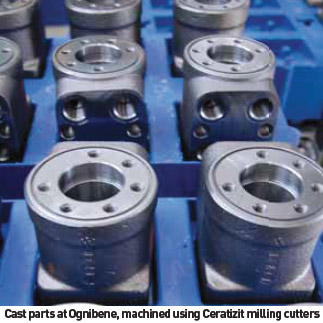 A professor-student team at the Missouri University of Science & Technology is advancing the argument that forging is the greenest net-shape manufacturing process, having recently performed a life cycle assessment study on the greenhouse gas emissions associated with the manufacturing of three different steering knuckles. The team found that the forged steel steering knuckle had significantly lower greenhouse gas emissions than either the cast aluminium or cast iron steering knuckle over their respective life cycles, which were divided into manufacturing, use and end-of-life phases.
A professor-student team at the Missouri University of Science & Technology is advancing the argument that forging is the greenest net-shape manufacturing process, having recently performed a life cycle assessment study on the greenhouse gas emissions associated with the manufacturing of three different steering knuckles. The team found that the forged steel steering knuckle had significantly lower greenhouse gas emissions than either the cast aluminium or cast iron steering knuckle over their respective life cycles, which were divided into manufacturing, use and end-of-life phases.
“As the steel industry and steel customers seek to reduce their environmental footprint, it is important to consider the entire life cycle in assessing environmental impact,” says David Anderson, Director of Long Products at the American Iron and Steel Institute (AISI). “While CAFE standards emphasise the use phase, a more important consideration is the environmental impact over the entire life cycle of the component or vehicle.”
Students at Missouri University of Science & Technology were awarded a Ferrous Metallurgy Education Today (FeMET) Design Grant from the Association for Iron and Steel Technology and AISI, based on their proposal to compare the greenhouse gas emissions produced over the life cycles of the steering knuckles. The students worked under Professor Kent Peaslee, who holds a Doctorate in Metallurgical Engineering and is the Associate Chair of the Materials Science & Engineering Department at the university. The FeMET grant programme is designed to seek innovative designs and solutions to industry-related issues.
The forged steel steering knuckle came from the rear suspension of a four-cylinder sedan and weighed 2.4kg, while the cast aluminum steering knuckle came from the front suspension of a six-cylinder minivan and also weighed 2.4kg. The cast iron steering knuckle was from the front suspension of a four-cylinder sedan and weighed 4.7 kg.
As the manufacturing processes vary for the different steering knuckles, software was used to analyse energy input and emissions for a particular steering knuckle’s method of production. The team used GaBi 4 Software, developed by the University of Stuttgart to make the assessments, as well as the ISO 14000 family classification, which includes life cycle assessments and inventories.
 The team found that the forged steel steering knuckle, produced the least amount of greenhouse gases throughout all the phases when compared with its cast aluminum and cast iron counterparts. Being relatively lightweight, the forged steel component did not consume a large amount of fuel in either the use or end-of-life phases.
The team found that the forged steel steering knuckle, produced the least amount of greenhouse gases throughout all the phases when compared with its cast aluminum and cast iron counterparts. Being relatively lightweight, the forged steel component did not consume a large amount of fuel in either the use or end-of-life phases.
Further, in producing the forged steel steering knuckle more recycled material was used than in producing the other steering knuckles. According to the US Environmental Protection Agency, more steel is recycled each year than all other materials combined, including aluminum, glass and paper. This recycled iron and steel saves the country 74% of the energy that would have been needed to make new steel.
Overall, the aluminium and cast iron steering knuckles had more factors contributing to emissions than the forged steel steering knuckle.
Correct tool selection builds efficiency
While the objective of casting and forging is to produce near net-shape components, machining to final dimensions remains the most critical of the subsequent value-adding processes, with correct cutting tool selection being of paramount importance.
This is confirmed by Albion Automotive, a wholly-owned subsidiary of American Axle & Manufacturing, a UK-based manufacturer of driveline systems such as axles, crankshafts and transmission components for OEMs that include Volvo, Caterpillar and Leyland Trucks. Producing over 12,000 axle sets per annum and in excess of 120,000 gears a year, the company seeks to make continual improvements in process and cost structure, highlighting a need to reduce manufacturing costs throughout its production facility.
Cutting tool supplier TaeguTec, in a review of certain manufacturing processes, has recently provided Albion with some positive results.
One particular example of cost improvements was noted on an Endomatic twin-spindle milling machine, which is used to mill an external part of an axle (half shaft) from forged EN19T steel with up to 10mm depth of cut. As the parts are manufactured from forgings, the skin on the parts created considerable flank wear with the original milling inserts. However, the introduction of TaeguTec’s TT7030 grade immediately reduced the wear.
The previous insert was running at a feed rate of 0.4mm/ rev and a running speed of 200rpm, with a table feed of 126mm and 125mm width of cut. Using the 200mm diameter face mill with 14 inserts, each with eight sides, the previous insert was machining 20 parts per edge. Operating at identical parameters, the change to the TaeguTec TT7030 grade now allows the production of 650 parts before needing an insert index. Furthermore, TaeguTec has reduced the insert edge cost per part from £0.57 to £0.04 – a cost saving of 93% to Albion.
Elsewhere, Italian steering systems manufacturer Ognibene is also seeking continuous improvement from the careful selection of cutting tools, this time from carbide specialist Ceratizit. The company’s HyperCoat product offers a particularly heat resistant combination of substrate and coating, namely the innovative carbide substrate of ISO class P and M35, in combination with a coating tailored specially to this application range. The new carbide grade is called CTP5240.
However, the real breakthrough in production resulted from the Ceratizit MaxiMill HEC milling system. Ognibene equipped all four of its CNC Makino lines with the Ceratizit HEC milling cutters, with a resulting 25% increase in production and a 39% cost saving when compared to previous methods.
“We were looking for ways to optimise the production of a special component made of GS400, of which we produce about 200,000 pieces per year,” says Francesco D’Agostino, Process Engineer at Ognibene. “The HEC system from Ceratizit is designed for high-efficiency milling, and it allowed us to drastically increase cutting data when rough milling – a solution we are very happy with.”
The cutting data for rough milling these GS 400 SG iron castings is now a cutting depth of 3.5mm at a surface speed of 800m/min, relating to 5000rpm, at a feed rate of 0.15mm/ tooth, which gives a traverse rate of 4500mm/min. Once the HEC system had proved itself on the roughing operations it was transferred to finishing cuts.
Solving large part size issues
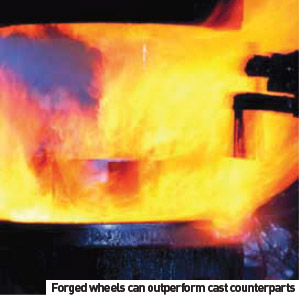 When machining castings, one problem is often the physical size of the parts in question, which can sometimes be larger than a half a cubic metre. In these instances, finding a high speed machine tool with adequate capacity can be difficult.
When machining castings, one problem is often the physical size of the parts in question, which can sometimes be larger than a half a cubic metre. In these instances, finding a high speed machine tool with adequate capacity can be difficult.
Aluminium pressure die-cast specialist, Metal Castings of Worcester, UK, has identified what it believes to be the best large capacity, light-duty machine for such applications – the HP400 horizontal machining centre from OKK, which is represented in the UK by Whitehouse Machine Tools.
As 80% of Metal Castings’ output goes to the automotive sector, the ability to maximise in-cut productivity and minimise non-cutting time is crucial to winning business and maintaining margins. Despite having a 630 x 620 x 710mm working envelope and a pallet swing diameter of 700mm, the HP400 accelerates at around 1g to 60m/min rapid traverse in all axes, cuts at up to 40m/min, exchanges tools in 1 second and completes a pallet change in five seconds.
Two OKK HP400 2APC machines have been installed at Metal Castings’ Worcester plant, together with a component washing machine and a leak tester to form a production cell, which runs 24-hours a day with one operator per shift.
As Metal Castings now has die casting machines up to 2,700 tonnes capacity, the number of large parts such as door frames and gearbox cases has started to increase – previously large castings were subcontracted out. A strong in-house machining capability was considered desirable to maintain control over customer deliveries and at the same time gain extra revenue from adding value to the larger castings.
“Pressure die castings used to be produced in very high volumes, running into hundreds of thousands over the lifetime of a product,” says Manufacturing Engineer Graham Jolliffe. “Now runs are generally much smaller due to shorter product life cycles and more frequent design changes. More and more of our customers want their castings supplied finish-machined. For most of our recent projects we tend not to use special purpose machine tools, which are difficult to change in production. Capacity changes, component modification through development, or re-tooling for nextgeneration parts all dictate investment in standard CNC machines that can be reconfigured easily.
“For our larger castings, we calculated that two horizontal spindle APC (automatic pallet change) machines would be more productive than three single pallet vertical machining centres,” continues Jolliffe. “However, most machines with a big working envelope generally have a powerful spindle motor with, for example, a BT50 or HSK taper and perhaps twin ballscrews in some linear axes, but we did not need such a high specification for cutting cast aluminium. Big machines also tend to have slower axis movements than their smaller, more nimble counterparts.”
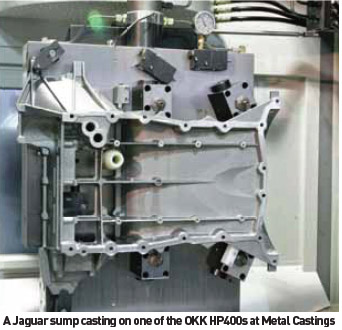 Castings machined on the HP400s at Worcester are generally more complex than components produced on the firm’s drill-tap models. While 60 seconds might be a typical cycle time on the latter, six minutes is more usual on the four-axis OKK machines and a gearbox casing can take more than 15 minutes.
Castings machined on the HP400s at Worcester are generally more complex than components produced on the firm’s drill-tap models. While 60 seconds might be a typical cycle time on the latter, six minutes is more usual on the four-axis OKK machines and a gearbox casing can take more than 15 minutes.
One of the first jobs produced in the OKK cell, which justified the investment, was the machining of a cast sump for a Jaguar engine in two operations, one per pallet. Current production level is 35,000 per year. Some tolerances are fairly tight, such as a cast dowel hole that needs to be opened out to within 0.011mm; and a milled face that has to be held within a 0.1mm profile to ensure accurate assembly of the sump to the engine.
A feature of the machine that supports the production of high accuracy components is the coolant management system, which uses seven individual pumps. In addition to 20 bar through-tool coolant, there are coolant jets around the spindle, a flume wash, a bed wash, a coolant curtain from the ceiling and a coolant gun. Media-free filtration is standard and refrigeration is included to avoid temperature variation of the coolant, which is important when cutting cast aluminium owing to its high co-efficient of thermal expansion.
Another post-casting process is grinding, which through the use of the latest technology, offers manufacturers the opportunity to further build value into raw casts. Case in point are the diamond electroplated grinding wheels from superabrasives specialist Engis that are now providing automotive foundries with a competitive edge, as well as increasing operator safety in foundry cleaning rooms. Engis electroplated grinding wheels are used in the cleaning of a variety of cast components for the automotive sector, including power steering pumps, brake rotors and automotive engine parts – ranging in weight from 1kg up to 450kg.
Because of their construction, Engis diamond electroplated grinding wheels can be operated safely at significantly higher speeds than conventional wheels, enhancing the efficiency of the grinding process by reducing the ‘chip load’ on each abrasive grain, thus reducing wear and extending wheel life. Furthermore, they do not need to be dressed or reconditioned during use, increasing the up time of the operation and maximising throughput.
In addition, the use of plated grinding wheels provides enhanced operator safety when compared to conventional bonded wheels because the body of a plated wheel has significantly greater integral strength than a bonded abrasive product, which can fail structurally when abused or when the maximum operating speed is exceeded.
One organization benefiting from these advantages is the American company Grede Foundries, located in Milwaukee, where Gary Dalgaard, Director of Manufacturing Engineering, says: “Engis has been a valued partner with Grede in the development of diamond wheels for robotic grinding. We continue to work with them to expand the use of these products to many other applications throughout the foundry. Their expertise and resourcefulness in this development has been a great asset to us.”
Finishing processes are also crucial as automotive manufacturers look to add value to their castings by providing distinctive product appeal via finishes or colours, or an enhanced performance such as longer operational life, closer tolerances, improved cutting performance or resistance to wear, rust or adhesion.
To fully benefit from these post-casting processes, professional surface preparation is a prerequisite, largely because the quality of the surface finish is often reflected by the quality of the substrate preparation.
Toyota has succeeded in cutting material losses to 0.05% when producing synchromesh clutch hubs in gearboxes using Höganäs’ powder technology.
Toyota had already made progress in reducing these losses before it started collaborating with Höganäs. The Japanese OEM wanted the synchromesh clutch hubs to have a better surface finish, in order to reduce post-processing, thus cutting waste. This required components being pressed with less variation in final dimensions and with minimal weight difference between units.
Höganäs’ response to this challenge was an innovative approach to binding agents and processing powder during pressing. The concept was based on a new zinc-free, press-ready bonded mixing concept called Starmix Boost.
The new powder mix has resulted in a new synchromesh clutch hub that is extremely stable in terms of density and weight. Waste is reduced, and the otherwise frequent adjustment of press settings has been eliminated, saving time. Material losses have been reduced to 5% of those seen using traditional methods and materials, further serving to reduce post-processing operations.
The collaboration has benefited both parties: Toyota has been able to take another step towards its vision of zero materials losses, while Höganäs has further extended the boundaries of powder metallurgy.
Blast finishing for complex casts
UK-based finishing specialist Guyson says that wheel-based blast finishing systems are well-suited to the saturation treat ment of large volume batches when metallic or ceramic media is required to de-flash or finish castings. With a very high mass discharge of media, a large blast pat tern and a high work output to energy input ratio, wheel systems have a cleaning rate well in excess of most air blast systems.
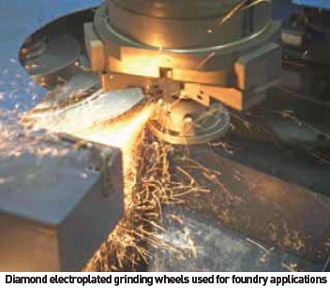 However, wheel systems cannot always provide a universal solution for foundry finishing. For example, they cannot be operated economically with some of the lower density and less impact resistant media such as aluminium oxide, glass bead or soft plastic. Such media can remove surplus deposits and return the key element of perceived quality, a cosmetic finish – they are also compatible for use with automated multi-gun, air-powered blast systems such as the Guyson Multiblast range.
However, wheel systems cannot always provide a universal solution for foundry finishing. For example, they cannot be operated economically with some of the lower density and less impact resistant media such as aluminium oxide, glass bead or soft plastic. Such media can remove surplus deposits and return the key element of perceived quality, a cosmetic finish – they are also compatible for use with automated multi-gun, air-powered blast systems such as the Guyson Multiblast range.
Precision cast compressor wheels in aluminium or turbine impellors in nickel super alloy are intricate, complex, delicately balanced, finished to close tolerances and have a high degree of metallurgical integri ty. The enormous impact force generated by a wheel system using a high-density metallic media to remove stubborn investment can prove too great, causing unacceptable distortion of the vanes.
However, using an air-powered Guyson RXS900 indexing rotary table machine with spindles rotating under the blast guns positioned to penetrate the vane recesses with either mineral, soft metal or even plastic abrasive media, tests show that impellors can be finished cleanly without damage or distortion and with improved substrate integrity.
Guyson also promotes cleaning/degreasing machines as part of its portfolio. The action of its ultrasonic models ‘scrub’ the casting surface via the implosion of millions of microscopic bubbles that lift the contaminants off component surfaces. The process is of benefit when spray cleaning or flood washing is unable to reach deep inside internal cavities and galleries for removing casting sand from exhaust manifold systems or hydraulic blocks.
Guyson recently installed two conveyorised Marr-Line tunnel washers in an automotive wheel manufacturing factory in the Czech Republic to improve quality assurance.
Both machines incorporate a wash, dry and cool process cycle. This permutation, proven through trials, was decided upon as the minimum requirement to clean the aluminium die cast wheels of production stains, oils and contaminants – including shot blast dust and media.
Near-net-shape manufacturing, in the form of casting and forging, remains the holy grail for automotive manufacturing engineers. In the meantime, many benefits are on offer for those prepared to try and optimise the existing process stream, from molten material and solidification through to machining, treatment and finishing.

































